Trailer mounts: Growing in popularity
22 December 2022
Why the humble trailer mounted platform is a good choice for both customers and rental companies
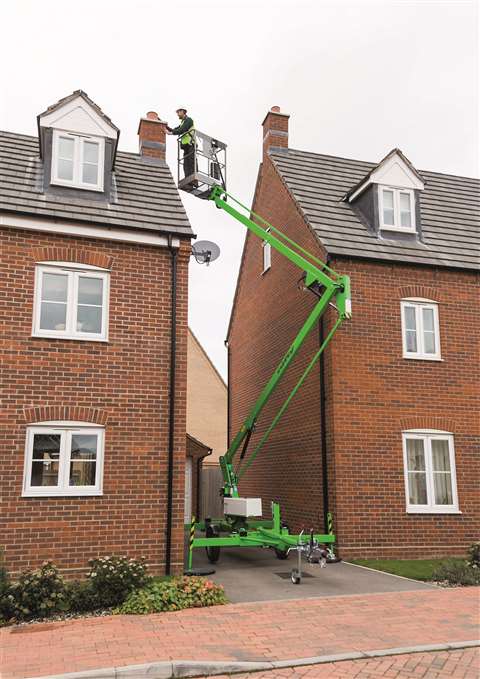 A typical Nifty application. (Photo: Niftylift)
A typical Nifty application. (Photo: Niftylift)
As Niftylift says, the trailer mount offers ease of operation but, most importantly, portability, as they can usually be towed behind a domestic vehicle.
This also means that when they are hired out, they don’t incur a large delivery charge, as customers can collect them.
Simon Maher, marketing manager at Niftylift, points out, “Add to this their ability to set up on most surfaces, due to their outriggers and they become a very versatile option for, particularly for short-term work.”
Ultimately, trailer mounts are favoured for their outreach rather than their working height.
Low level outreach is often essential, as demonstrated by the Nifty 120T, one of Nifty’s most popular trailer mounts, along with the 150T, 170 and latest model, the 210.
“We are also seeing an overall move towards including our Traction Drive and Bi-Energy power options on machines” says Maher.
Niftylift’s Traction Drive is an integrated drive system that assists with manoeuvring the trailer mount once on-site, enabling a single operator to move the machine.
The manufacturer’s Bi-Energy is the combination of an IC engine with either battery or AC power inside as well as outside.
Trailer mounted platforms as a rental product
Certainly, trailer mounts are here to stay. “They are often an ‘entry machine’ for new rental companies starting in powered access.
“Many rental companies now realise the higher profit margins that can be made on trailer mount hires, as the customer base for these machines doesn’t wield the same buying power that the self-propelled customers, often large construction companies, do.”
This is also demonstrated by the residual values of Nifty trailer mounts in the used equipment market, concludes Maher.
The flexibility of trailer mounted models
JLG points to the simple effectiveness of trailer mounts in the workplace. “Towable boom lifts offer many advantages on job sites, but by far, the biggest one is that these machines provide operators reach and mobility, combining the flexibility of a small utility vehicle with the versatility of a self-propelled lift and platform,” says Craig Edwards, vice president, national accounts, at JLG.
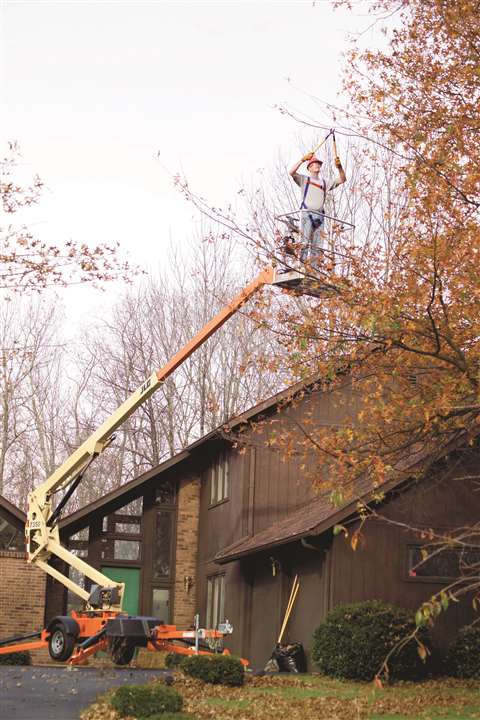 The JLG T350 Tow-Pro carrying out tree trimming work.
The JLG T350 Tow-Pro carrying out tree trimming work.
“Many workers choose to use this type of machine on project sites because it has the ability to be easily moved into position, and it allow workers to gain the reach needed to complete work at height,”
This level of flexibilty can be vital in situations where quick action is required. JLG’s Tow-Pro Series can tackle the same jobs as other electric or gas-powered boom lifts but with an easier option for transportation. Available in two models, the T350 and T500, the series is ideal for disaster relief tasks, like tree trimming, or disaster clean-up efforts, like reconstruction, exterior painting or maintenance tasks.
The units offer a choice of a 24V DC electric or 9 HP gas-powered engine. And with the standard combination hitch, 65 mph towing speed and hydraulic auto-leveling outriggers, it can be brought to the job site and set to work quickly. They also offer standard air and water lines to the platform, while their detachable platform controls provide efficient boom positioning with one-hand operation of all boom functions. Plus, the accessory mounting tray accommodates a generator, air compressor or pressure washer.
As Edwards goes on to explain, the features of the Tow-Pro Series reflect the overall benefits of the trailer mount equipment sector, compared to other solutions.
For example, they are lightweight, simple to operate and setup and easy to transport, making it an affordable solution to accessing height. They are also effective in areas that might not support a heavy machine and allows the user to transport it without delivery service.
Ultimately, trailer mounted platforms are purpose-built for applications that focus on tasks requiring access to height without the need for long-term usage. Edwards adds, “Because towable boom lifts can be brought to the job site and begin working in no time, these machines are ideal to use to complete a wide variety of everyday home, business, municipality construction and maintenance applications, as well as seasonal tasks, like tree trimming, decorating, lighting, exterior painting and maintenance.”
Trailer mounts increasing in popularity
Haulotte features a full range of trailer mounted equipment including a 36ft telescopic boom and four articulating booms at 35, 45, 55, and 65ft platform heights.
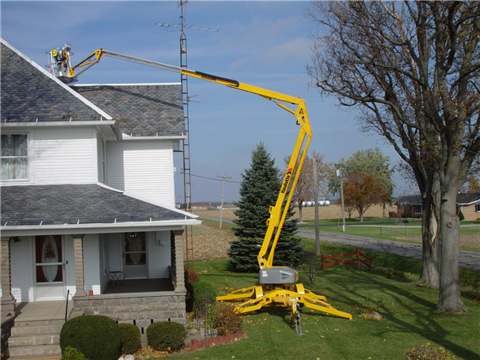 Haulotte’s trailer mounts are increasingly being used for applications in the residential sector. (Photo: Haulotte)
Haulotte’s trailer mounts are increasingly being used for applications in the residential sector. (Photo: Haulotte)
Where the company sees significant growth is residential use of these machines by homeowners.
“During the pandemic we saw a growing number of homeowners decide to tackle home maintenance projects like tree removal or pruning.”
The first Haulotte machine was released in 2005, with the most important feature being the one touch auto-leveling feature, meaning operators can get to work in less than 30 seconds of set up time.
Then, Haulotte’s controls box provides electric piloting capability with ruggedised button switches laid out next to a drawing of the machine.
Haulotte’s entire range of trailer mounted machines also come standard with air and water hoses routed up to the platform.
Electric powered trailer mounts
Electrification has been the largest trend in the equipment industry in general, adds Haullotte. The company’s full range is battery powered with capacity to operate a full day on a single charge.
“We also have an optional range extending generator available to extend the working day as needed.”
Finland-based Dinolift’s latest models are the Dino 120TB and Dino 105TL. They are the smallest lifts in the Dino range, with 10.5m and 12m working height.
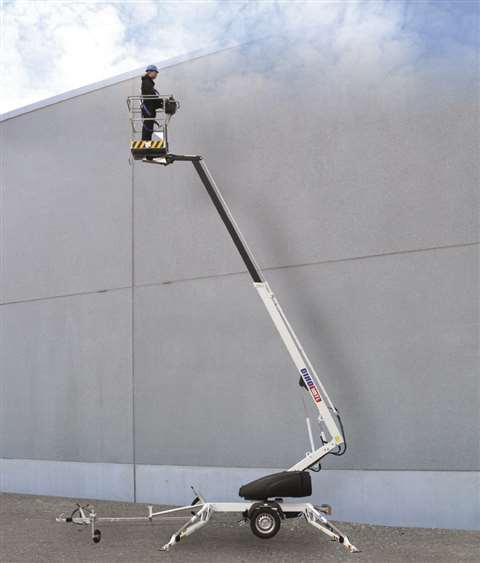 The DINO105TL trailer mount. (Photo: Dinolift)
The DINO105TL trailer mount. (Photo: Dinolift)
The 120TB is a battery powered version of 120T, which is 230VAC powered.
The 105TL is the smallest of all and is popular because of a very low weight of 950kg, says Dino, which allows it to be towed with most regular cars.
Market demand for trailer mounts
The main markets for its trailer mounts are the Nordic countries, Baltics, Central Europe and Australia and the company is seeing increasing sales in the US.
Santtu Siivola, Chief engineer at Dinolift comments, “Any market looking at working height versus life cycle cost efficiency is a market for trailers.
“Also, markets with long distances are generally looking for towable machines. There is a lot of demand for used towable lifts and we have especially seen a significant impact of the wide and heterogenous after market on the quite high price level for used Dinos.”
Siivola adds, “Also end-user segments are generally investing more in towable lifts and especially in the US we see a demand for our higher models in those customer segments.”
Jussi Saarikallio, Dinolift’s regional manager, explains that customers and end users want simple usability at a low cost. “This is, of course, something we are constantly working on,” he says.
“And making lifts even more light is both from a sustainability point of view and a towing point of view important and a design principle.”
Will trailers be able to be towed by the increasing number of electric cars on the road?
Saarikallio answers, “Regarding electric cars and their towing capacity, there are already numerous cars with sufficient towing capability, and it is of course not only lifts that are towed behind cars, also campers and trailers for boats.”
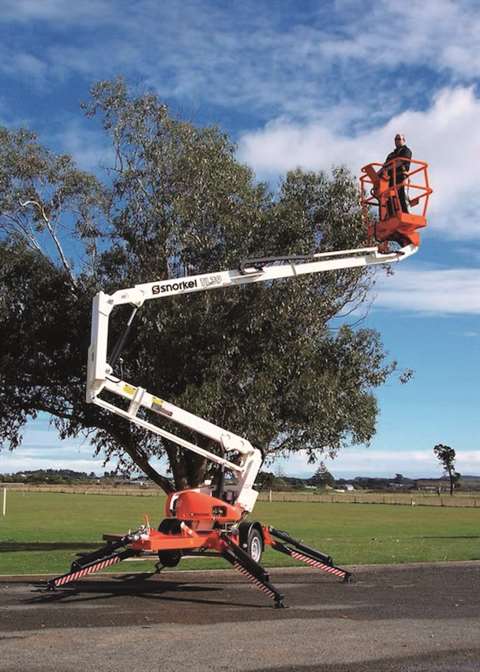 The Snorkel line of towable boom lifts features the TL37J, TL39 (pictured) and TL49J models. (Photo: Snorkel)
The Snorkel line of towable boom lifts features the TL37J, TL39 (pictured) and TL49J models. (Photo: Snorkel)
Entry-level aerial equipment
The Snorkel line of towable boom lifts features the TL37J, TL39 and TL49J, with the features customers like most including the quick setup, ease of operation, and the fact that they’re simple to service and maintain.
Snorkel towable boom lifts also offer self levelling for the outriggers and come with an optional wheel kit they can be self-propelled for short distances.
The lifts are equipped with a 24V battery operating system with two operation options; a petrol engine and petrol/battery bi-energy.
Robby Hagan, senior vice president of sales, Xtreme Manufacturing and Snorkel, says, globally there is an increase in the use of towable boom lifts as they are an inexpensive entry point into aerial equipment. “Users can simply ‘tow & go’ as opposed to the traditional full-sized self propelled boom lifts.”
Some common uses are tree trimming, window washing, sign maintenance, general rental, painting and building maintenance.
Looking to the future, Hagan believes lithium-ion technology is growing in popularity.
“Longer usage between charges and zero-maintenance batteries are a plus when utilising a mobile piece of equipment at many different locations during a day, week or month,” he says.
“Also, there is a demand for lighter weight towable lifts as many homeowners are renting towable machines and using their smaller personal vehicles to tow them.”
Trailer mounted access: technology updates
In Germany, Rothlehner took over the assets and rights of the Denka Lift brand in 2013 and brought the production to Germany.
In recent years, the company has developed the products further, with a number of improvements and options to bring them up to date.
These include a new software-based control system with integrated onboard diagnostics, charging technology, sensor electronics for levelling the basket, automatic outrigger setup and LED lights in the basket.
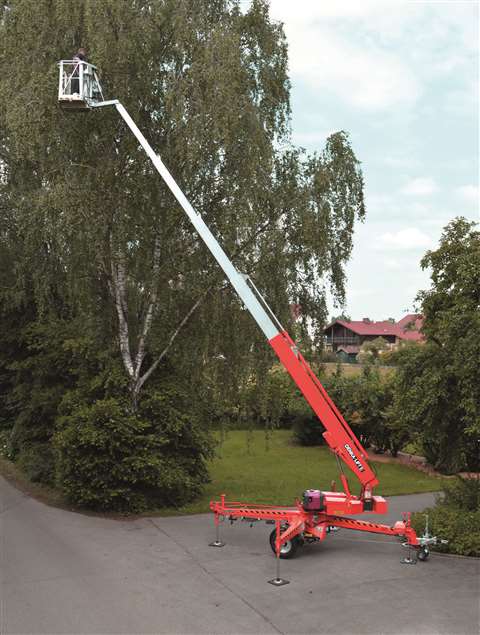 Rothlenher’s Denka-Lift DK25 model. (Photo: Denka Lift)
Rothlenher’s Denka-Lift DK25 model. (Photo: Denka Lift)
And work has been done on the maneuvering characteristics. These have been significantly improved in the DK-Series, with its basket to the rear.
Simple operation is key, and the units have a stable and durable telescopic boom made of extruded aluminum profiles, says Rothlehner, with the most popular still being the DK18 and DK25, and the DL series DL18/21 and DL25/30, with a basket to the front.
Trailer mounts with multiple towing options
The 12.19m working height TZ-34/20 and 16.92 m TZ-50 are Genie’s offerings in the trailer mount market, both providing a platform capacity of 227kg.
Both the TZ-34/20 and the TZ-50 can be towed behind many different models of pickup truck or SUV.
Once on site, dual pneumatic jockey wheels make it easy to precisely position the machine.
An optional Drive and Set lets operators drive the unit from the platform when fully lowered, while Up-and-over boom angles, plus 359° non-continuous turntable rotation further assists platform positioning.
The Genie TZ models also boast the operating envelope of a Genie Z boom, including the ability to reach up, over and out.
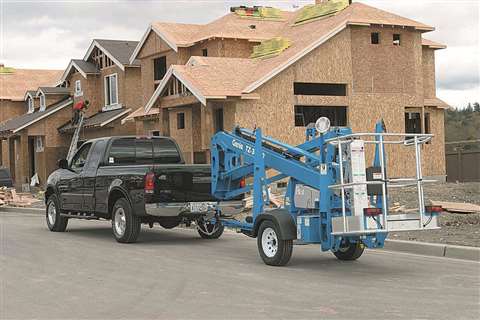 Genie’s TZ-34/20 and TZ-50 offer working heights of 12.19m and 16.92m respectively. (Photo: Genie)
Genie’s TZ-34/20 and TZ-50 offer working heights of 12.19m and 16.92m respectively. (Photo: Genie)
Simone Manci, at Genie, comments, “Trailer mounted booms have long been a staple for rental companies.
“Additionally, they are a popular rental category with major home improvement centres, where they can be towed to the jobsite.”
Manci adds, “Contractors typically use trailer mounted booms for painting, trim work and roof projects.
“A municipality or university might rent or even own a trailer mounted boom for jobs such as general maintenance and cleaning of building exteriors, changing lights in parking lots or garages.”
Genie trailer mounts are finding popularity in North America, China, Australia, and the Asia Pacific region, and there are new opportunities.
Extra small trailer mounts
Comet has two models, the Xtrailer 12 and Xtrailer 14 with 12m and 14m working heights. These are even more light and compact compared to other trailer mounts on the market, small in size and able to reach difficult access areas towed by an ordinary vehicle.
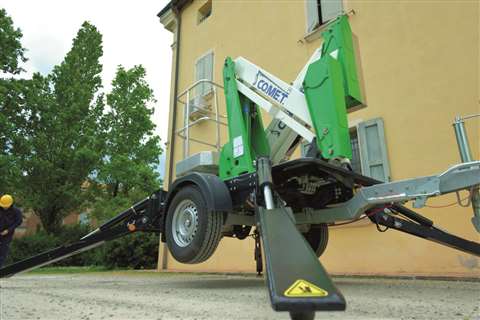 One of Comet’s X-Range trailer mounts. (Photo: Comet)
One of Comet’s X-Range trailer mounts. (Photo: Comet)
They were both launched a few years ago, but have been updated, including with the introduction of the Comet high life hybrid system.
This system allows the machine to work in hybrid with twin engines full electric. The result is no noise pollution and an eco-friendly environment.
The company is considering launching new models for different market niches, as well for train maintenance.
“They have very low running costs and small companies of craftsmen, such as painters, electricians, antenna fitters, are our main customers,” says the company.
“Another growing trend is customers’ demand and interest for hybrid models that can work without making noise and without polluting.”





